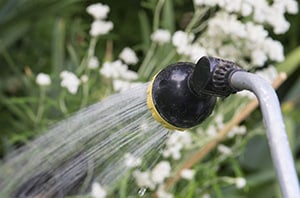By Nadie VanZandt, UVM Extension master gardener
Conserving water is always a good idea, and if the dry weather of the last two summers is any indication, such practice should become habit.
Fortunately, you can learn from gardeners in arid climates how to successfully grow plants during droughts. These tried-and-true sustainable practices protect and insulate your plants to yield a bumper crop.
A healthy soil amended with compost is your first defense against drought. Besides nourishing your plants, compost enables water retention. You can work the compost into the soil around established plants.
A good second defense is to adopt companion planting, the practice of growing plants together that physically and chemically complement each other. This improves productivity, discourages diseases and pests and maintains a healthy soil.
The best-known example of companion planting is the clever use of corn, pole beans and winter squash by Native Americans. They called this trio the Three Sisters, and it has many benefits.

Targeting the base of garden plants using a watering wand attached to a hose saves water and prevents fungal diseases.
The corn stalks support the pole beans, which in turn, fixate the nitrogen in the air to the soil. The large squash leaves shade the soil and act as mulch while their prickly edges discourage weeds and pests.
When using companion planting, consider spacing plants so their leaves barely touch when full-grown. This keeps the soil surface cool.
A third defense against drought is to use hydrozoning, the method of grouping plants with similar watering needs to conserve water. For example, deep-rooted vegetables, such as asparagus and tomato, should be placed together to benefit from deep, but less frequent, watering.
Similarly, shallow-rooted plants, such as strawberries and bush beans, planted together benefit from shallow, but frequent, watering.
Even sun lovers appreciate a little shade. In an established garden you can spread a shade cloth over vulnerable plants. Some gardeners even use patio umbrellas.
Heavy mulching is another way to keep the soil moist and cool. About 2-3 inches of organic mulch such as straw or grass clippings will do the trick. Avoid hay as it may contain weed seeds.
Most importantly, water wisely and with the right tools. Water early in the morning before the heat of the day. Avoid overhead sprinklers because most of the water is wasted through evaporation.
Targeting the base of the plants saves water and prevents fungal diseases. A simple watering wand attached to your hose will do the job. Less frequent and deep watering will benefit deep- rooted plants, such as tomatoes, pumpkins, parsnips, artichokes and watermelon.
To make a deep-rooted irrigator you can use a simple PVC pipe. Cut a 2-inch-diameter PVC pipe in 2-foot lengths. Starting 8 inches from one end, drill 1/4-inch holes every two inches along the rest of the pipe for drainage.
Cover the pipe with a piece of open-weave shade cloth tied securely to one end of the pipe with a plastic tie. The shade cloth prevents debris and rodents from entering the pipe.
Dig a hole next to the plant and bury the pipe, open end down, with the holes facing the plant. For easy access, leave 3-4 inches of pipe above ground. Place your hose over the shade cloth to water the deep roots through the pipe. For plants with shallower roots, use soaker hoses.
Reduce watering after the plants are established and resume when flowering and fruit setting begins.
Finally, control weeds to ensure your plants do not compete for nutrients and water. Make a ritual of removing weeds before they flower and make seeds.
Waterwise practices make sense in a changing climate. With a few changes, you can still reap a bountiful harvest, protect a precious resource and save money in the process.



